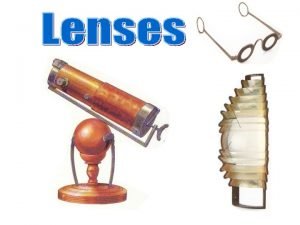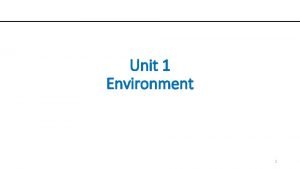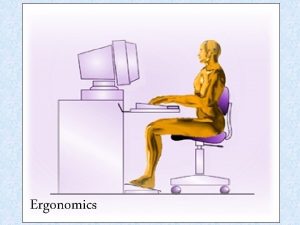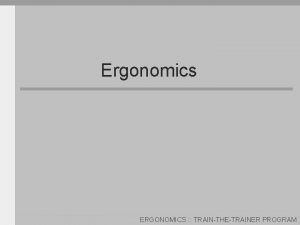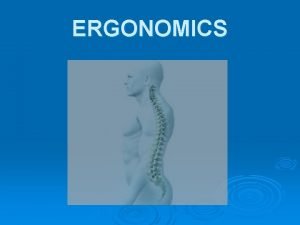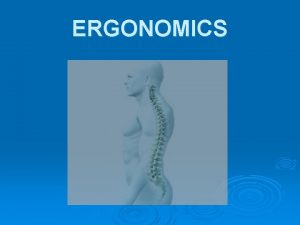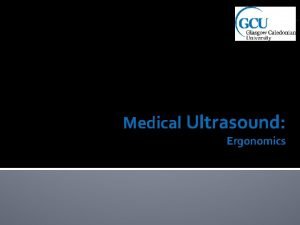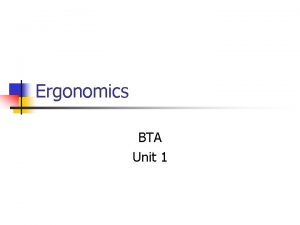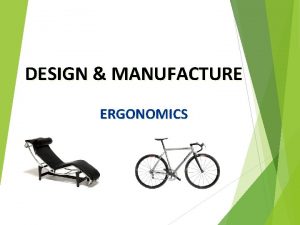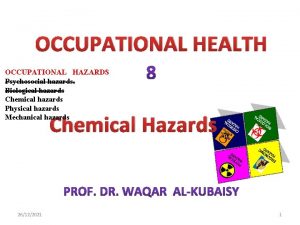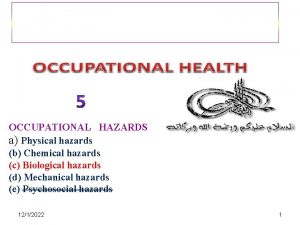Ergonomics Hazards The word ergonomics is derived from




















- Slides: 20

Ergonomics Hazards The word ergonomics is derived from the Greek language. Ergon is Greek for work; and nomos means laws. üThis topic discusses the physical condition of the workplace such as the workstation, work equipment and posture during work. ü Advanced and sophisticated equipment used at the workplace often pose risks to their users and expose them to body injuries in the long run. üBasically, these injuries show their effects only after some time. üErgonomics is also defined as the ’systematic application of knowledge about the physiological, physical, and social attributes of human beings in the design and use of all things which affect a person's working conditions: equipment and machinery, the work environment and layout, the job itself, training and the organization of work’ üIn other words, ergonomics seeks to adjust tasks to the worker through equipment design and work procedure. 1

What is meant by ergonomics and how important is it to workers? ØVarious industries are now using ergonomics increasingly in order to enhance human productivity, quality of working environment, and occupational safety and health. ØStudies have shown that people working at ergonomic workstations or using ergonomic equipment are less likely to experience fatigue, discomfort, or stress. ØIn other words, ergonomics involves ‘using a special design to make tasks more compatible with humans and not to force humans to be more compatible with tasks’. ØAs such, ergonomics deals with various aspects ranging from physical stress on the muscles, nerves, bones, tendons, and ligaments to environmental factors which affect hearing, vision, comfort and health. 2

Legal Requirements And Ergonomics Application • The Occupational Safety and Health Act, 1994 ‘the employers, who create risks for their workers, must ensure the safety and health of their workers at the workplace. • One of the objectives of this act is to create working conditions that meet the physiological and psychological needs of the workers. Thus, employers are responsible of establishing a safe work system which does not pose any health risks to the workers 3

Ergonomic Elements-4 4

Physical Stress Variables-8 creates stress on the back, legs and feet 5

a stationary job: a production operator The potential for physical stress increases with stationary jobs when workers fail to take such precautions as periodically standing/ stretching/ moving. 6 A construction worker requires more strength/ power on the jobs that demand larger amounts of strength/power are generally more stressful than those requiring less. The proper sitting posture when taking a rest Improper sitting posture Proper sitting posture

ü Good versus Bad Horizontal Work Area A good horizontal work area is one that is designed and positioned so that it does not require the worker to bend forward or to twist the body from side to side. Bad horizontal work surfaces increase the likelihood of physical stress. ü Good versus Bad Vertical Work Area Good vertical work areas are designed and positioned so that workers are not required to lift their hands above their shoulders or bend down in order to perform any task. Vertical work areas that do require these movements are bad. Bad vertical work areas increase the likelihood of physical stress. ü Non-repetitive versus Repetitive Motion Repetitive motion jobs involve short-cycle motion that is repeated continually. Repetition can lead to monotony and boredom. When this happens, the potential for physical stress increases. ü Low versus High Surface Contact Surface stress can result from contact with hard surfaces such as tools, machines, and equipment. High surface contact jobs tend to be more stressful in a physical sense than are low surface contact jobs. ü Presence versus Absence of Environmental Factors For example, personal protective equipment, although conducive to reducing environmental hazards, can increase the amount of physical stress associated with the job. 7

Ergonomic problems indicators-7 8

(a) Apparent Trends in Accidents and Injuries By examining accident reports, record-keeping documents, first-aid logs, insurance forms. A high incidence rate of a specific type of injury typically indicates that an ergonomic problem exists. (b) Incidence of Cumulative Trauma Disorders (CTDs) Factors associated with CTDs include a high level of repetitive work, greater than normal levels of hand force, awkward posture, high levels of vibration, high levels of mechanical stress, extreme temperatures, and repeated hand-grasping. For example, a worker who uses a concrete/asphalt breaker frequently is exposed to white finger syndrome due to high vibration. (c) Absenteeism and High Turnover Rates High absentee rates and high turnover rates can be indicators of ergonomic problems. People who are uncomfortable on the job to the point of physical stress are more likely to miss work or leave for less stressful conditions. (d) Employee Complaints A high incidence of employee complaints about physical stress or poor workplace design can indicate the presence of ergonomic problems. For example, a typist might complain that her chair is too high causing physical stress to legs and back. 9

10

(e) Employee-Generated Changes Employees tend to adapt the workplace to their needs. For example, workers may place additional padding on their chairs, modify protective equipment, install additional lights. (f) Poor Quality Poor quality, although not necessarily caused by ergonomic problems, may be the result of ergonomics. Poor quality is at least an indicator. (g) Manual Material Handling The incidence of musculoskeletal injuries is typically higher in situations that involve a lot of manual material handling. Musculoskeletal injuries increase significantly when the job involves one or more of the following: 1. Lifting large and bulky objects 2. Lifting objects from the floor 3. Lifting frequently Lifting heavy objects inappropriately and not receiving proper training can lead to musculoskeletal injuries. When such conditions exist, the company has ergonomic problems. 11

The following rules must be taken into consideration when adapting the job to the worker: 1. Nerve conduction velocity, hand-grip strength, muscle mass, range of motion, and flexibility all begin to diminish upon reaching the age of 45. 2. Weight and mass tend to increase throughout the age of the early fifties (50) 3. Height begins to slowly diminish from the age of 30 4. Lower back pain is more common in people 45 years of age and older 5. Visual acuity at close range diminishes with age. These rules mean that employers cannot take a "one-size-fits-all" approach to ergonomics. Adaptations for older workers must be individualized and should take aging factors into account. " "ﻣﻘﺎﺱ ﻭﺍﺣﺪ ﻳﻨﺎﺳﺐ ﺍﻟﺠﻤﻴﻊ 12

HAZARD PREVENTION AND CONTROL q. In dealing with ergonomic problems, it is more cost-effective for employers to take proactive actions to prevent ergonomic stress. q Engineering solutions, where feasible, are the preferred method for ergonomic hazard prevention and control q The focus of an ergonomics programme is to make the job fit the person not to make the person fit the job. q This is accomplished by redesigning the workstation, work methods, or tools to reduce the demands of the job, including high force, repetitive motion, and awkward postures. q 3 examples of engineering controls that have proven to be effective and achievable. 13

14

15

Apart from engineering controls, the following steps can be used to prevent and control ergonomic problems. (a) Periodic Health Surveillance Periodic health checks (every two to three years) should be conducted on all workers who are assigned to positions involving exposure of a particular body part to ergonomic stress. (b) Ergonomic Programme An effective ergonomics programme must include continuous training and education. The purpose of training and education is to ensure that employees are sufficiently informed about the ergonomic hazards to which they may be exposed and thus able to participate actively in their own protection. 16

The Education Programme must expose workers to: 1. 2. 3. 4. Types of CTDs and preventive measures; Causes of CTDs; Early signs and symptoms of CTDs; and Treatments for CTDs. Through such education and training programmes, CTDs can be detected at an early stage, hence reducing their effects. (c) Early Report of CTD Symptoms Employees should be encouraged to report early signs and symptoms of CTDs to the in-plant health facility. This allows for timely and appropriate evaluation and treatment by employers. 17

18

19

Summary 1. Ergonomics is important to ensure the quality of life of workers, prevent productivity from declining and enhance work performance 2. It takes some time for workers who are exposed to illnesses due to inappropriate workstations, work processes and work equipment to realize that they have actually fallen ill 3. Employers must take proactive measures and implement ergonomics programmes to educate workers on ways to overcome ergonomic risks, and provide suitable workstations, equipment and processes. 20
 Limitations of auditing
Limitations of auditing Of good report meaning
Of good report meaning Concave lens
Concave lens The word precis is derived from french word which means
The word precis is derived from french word which means The word bank is derived from the latin word
The word bank is derived from the latin word The two greek words of the word geometry are geo and metro.
The two greek words of the word geometry are geo and metro. Photography comes from the greek words photos and graphos
Photography comes from the greek words photos and graphos Forensic is derived from the latin word
Forensic is derived from the latin word Advent comes from the latin word adventus which means what
Advent comes from the latin word adventus which means what Greek word physics
Greek word physics Litera root words
Litera root words Horticulture history
Horticulture history Earliest
Earliest Logia meaning in education
Logia meaning in education Latin word scientia, meaning “knowledge
Latin word scientia, meaning “knowledge Environment derived from which word
Environment derived from which word Community vs society
Community vs society Kutub senama
Kutub senama The word authority is derived from
The word authority is derived from Trigonometry greek word
Trigonometry greek word Conditional evidence
Conditional evidence


